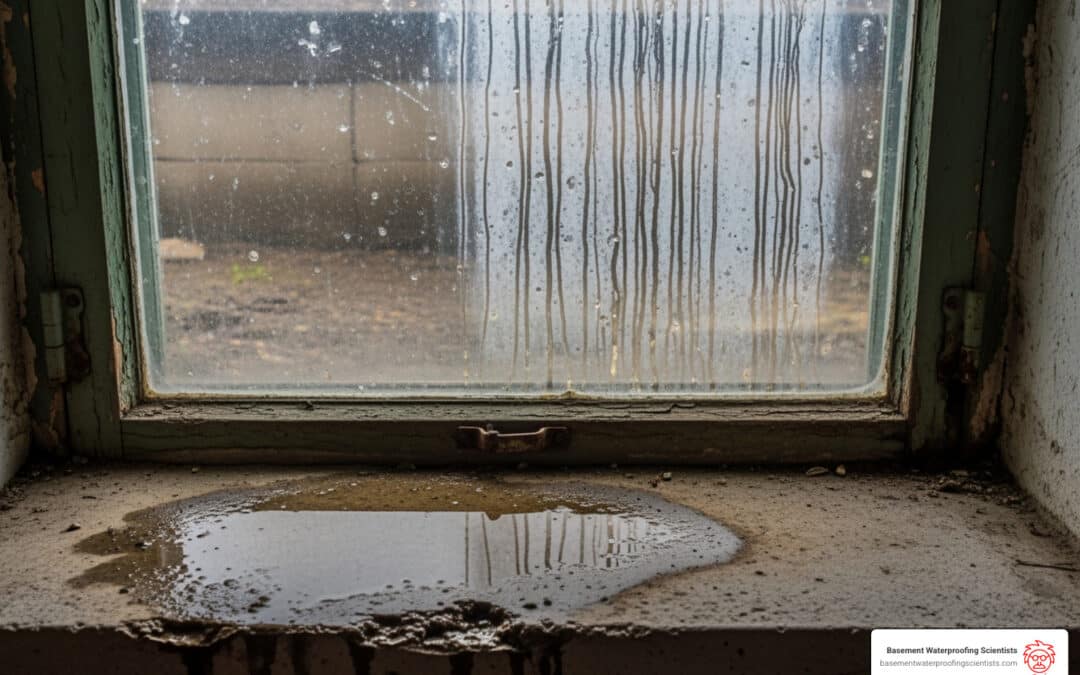That Drip is a Bigger Problem Than You Think
Basement window leak repair starts with understanding that a small drip can signal serious trouble. What seems like a minor issue today could become thousands of dollars in damage tomorrow.
Quick Fix Checklist for Basement Window Leaks:
- Check and clean clogged gutters – redirect water away from foundation
- Seal gaps around window frame – use silicone caulk for immediate protection
- Clear window well debris – remove leaves, dirt, and standing water
- Inspect foundation grading – ensure soil slopes away from house
- Apply temporary waterproof coating – buy time while planning permanent repairs
Over 60% of basements have moisture problems, and windows are a common entry point for water. That water stain could be the first sign of:
- Mold growth threatening your family’s health
- Foundation damage compromising your home’s structure
- Ruined belongings stored in your basement
- Decreased property value
The good news is that most leaks start small, giving you time to act. Catching issues like deteriorated caulk, a clogged window well, or poor drainage early can save you thousands.
Don’t let a small leak become a big problem. The sooner you address the root cause, the less expensive the repair will be.
I’m Darin Garvey from Basement Waterproofing Scientists. With over 30 years of experience solving basement window leak repair challenges in the Philadelphia area, I’ll guide you through how to identify, assess, and fix your leaky basement window, and explain when to call a pro.
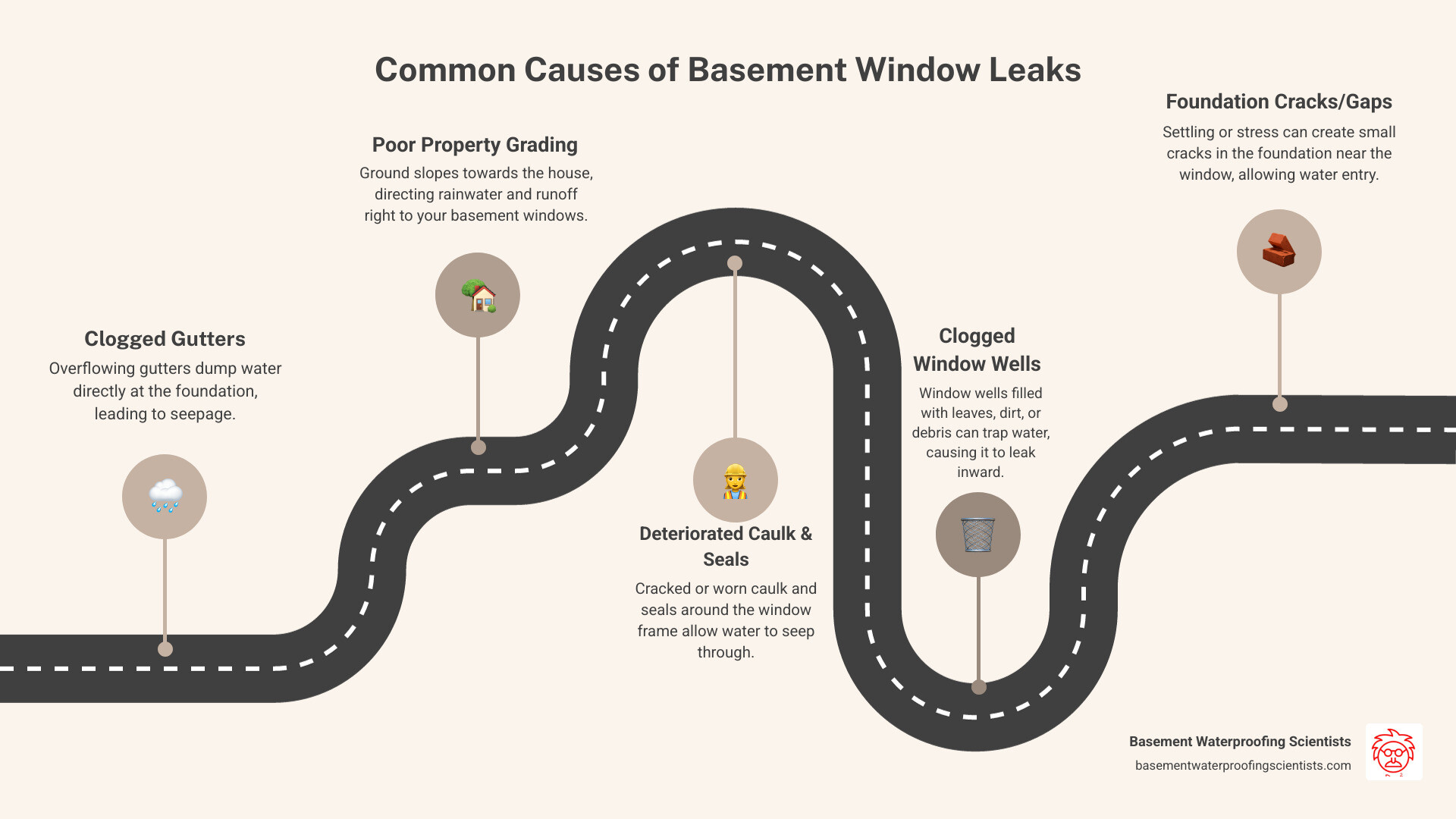
Simple guide to Basement window leak repair terms:
Step 1: Pinpoint the Leak’s True Source
Before starting any basement window leak repair, you must find the exact source of the water. Guessing can lead to frustration and failed repairs, as a simple surface fix often won’t solve a deeper problem.
Look for these visible signs:
- Water stains or damp spots on walls or floors near the window.
- A musty, earthy odor, which signals moisture and possible mold.
- Peeling paint or wallpaper that is bubbling or flaking.
- Puddles of water on the floor, especially after rain.
Once you spot these signs, inspect both the exterior and interior of your home.
Exterior Inspection:
- Check for cracks in the foundation or masonry next to the window.
- Look for old, cracked, or missing caulk around the window frame.
- Inspect gutters for clogs and ensure downspouts direct water away from the foundation.
- Examine window wells for debris or standing water.
- Ensure the ground slopes away from your house, not towards it.
Interior Inspection:
Carefully check the window frame, the surrounding wall, and the floor below for any cracks, dampness, or discoloration.
The “Hose Test” Method
This test helps pinpoint the leak’s entry point.
- Prepare: Ensure the area inside is dry. Place paper towels on the windowsill and floor to spot new water easily.
- Spray: From outside, use a garden hose to systematically spray water on the window glass, then the frame, the caulk lines, the window well, and finally the wall around the window.
- Observe: Have a helper inside watch for when and where water first appears.
- Grading Test: If the leak doesn’t appear, soak the ground around the window well to simulate heavy rain. This can reveal issues with grading or hydrostatic pressure.
A thorough check is key for any successful basement window leak repair. For more signs of trouble, see our guide on 8 Signs Your Basement Needs Waterproofing.
Common Causes of a Leaky Basement Window
Knowing the cause is the first step to a real fix.
- Clogged Gutters & Downspouts: If gutters are full, water overflows and pools around your foundation and windows.
- Negative Property Grading: If the ground slopes towards your house, it funnels water directly to your foundation.
- Deteriorated Caulk and Seals: Old caulk cracks and shrinks, creating gaps for water to enter.
- Damaged Window Frames: Older wood or steel frames can rot, rust, or warp, breaking the waterproof seal.
- Clogged Window Wells: Debris in window wells can block drainage, causing water to build up against the window.
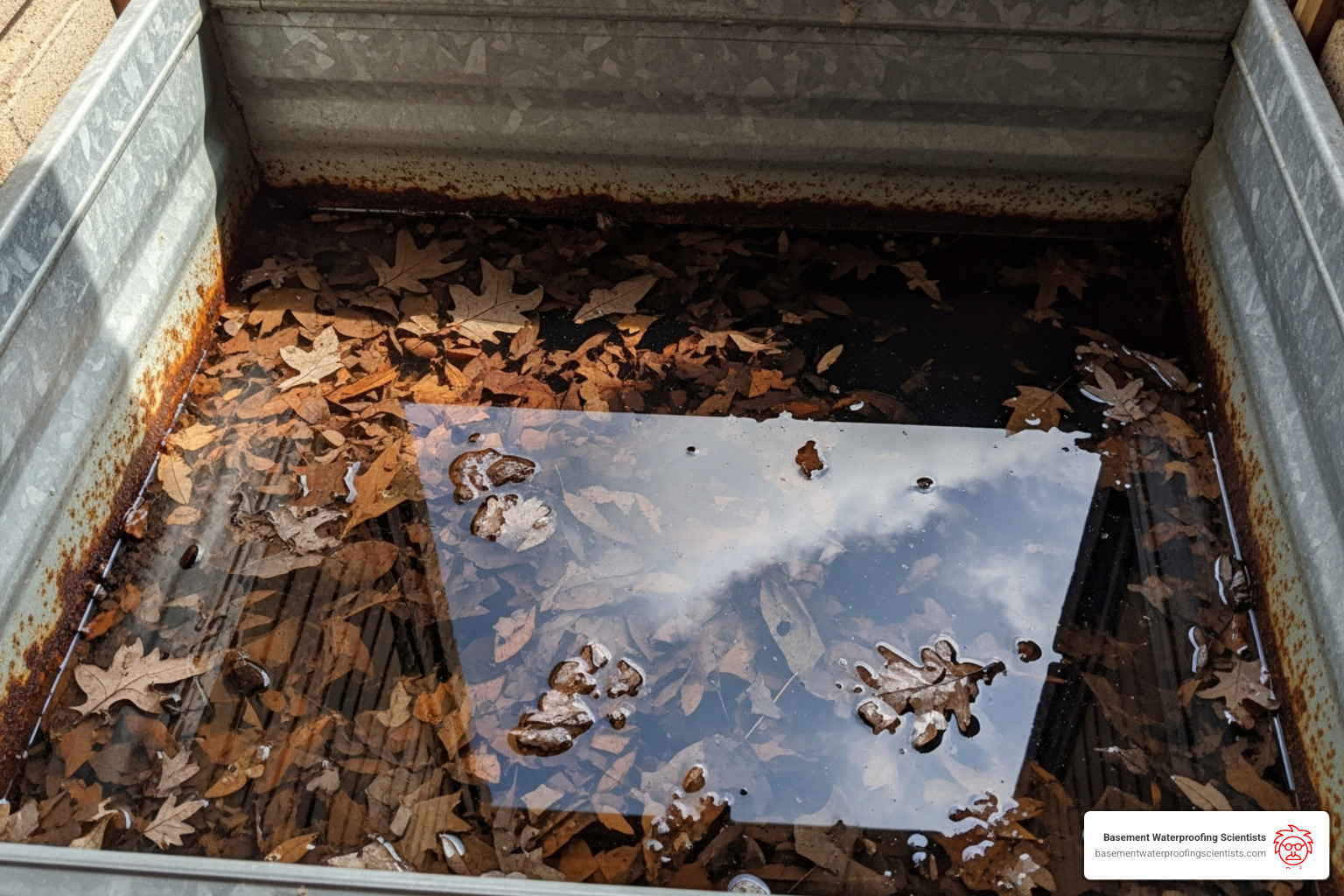
- Foundation Cracks Near the Window: Cracks in the foundation near the window are a common entry point for water under pressure. Learn more about How to Seal Exterior Foundation Cracks.
Understanding these causes is crucial for a successful basement window leak repair!
Step 2: Immediate Actions to Control Water Damage
Finding water from a basement window requires quick action to prevent costly damage. Here’s what to do immediately:
-
Contain the water: Use towels for small leaks or buckets for active drips. A temporary barrier of sandbags or rolled-up blankets can help with larger flows.
-
Remove standing water: A wet/dry vacuum is the most effective tool. The faster you remove the water, the less damage it can do.
-
Move your belongings: Get any valuable or sentimental items away from the wet area. If you can’t move heavy furniture, lift it onto blocks.
-
Dry the area: Use fans to circulate air and a dehumidifier to pull moisture from the air. This helps prevent mold growth and musty odors.
-
Document the damage: Before cleaning up, take photos and videos of the leak and any damaged items for insurance purposes and professional assessment.
These are temporary measures to control the situation while you plan a permanent basement window leak repair. For more comprehensive water issues, see our guide on Basement Water Leak Repair.
Step 3: Your Guide to DIY Basement Window Leak Repair
Not every basement window leak repair requires a professional. For minor leaks, a little DIY work can stop small problems from becoming expensive headaches.
Fix #1: Sealing and Caulking Gaps
Old, failing caulk is a common culprit and often the easiest DIY fix. Use a high-quality, silicone-based caulk for a flexible, waterproof seal.
- Gather tools: You’ll need a caulking gun, utility knife, silicone caulk, and a damp cloth.
- Remove old caulk: Scrape away all the old, degraded caulk from around the window frame. A clean surface is essential for a good seal.
- Clean the surface: Wipe the area with a damp cloth to remove dust and debris, then let it dry completely.
- Apply new caulk: Cut the tip of the caulk tube at a 45-degree angle. Apply a steady, continuous bead of caulk along the seam where the window frame meets the foundation.
- Smooth the bead: Use a wet finger or a caulking tool to smooth the bead, pressing it into the crack for a tight seal. Wipe away any excess.
- Let it cure: Allow at least 24 hours for the caulk to cure before it’s exposed to rain.
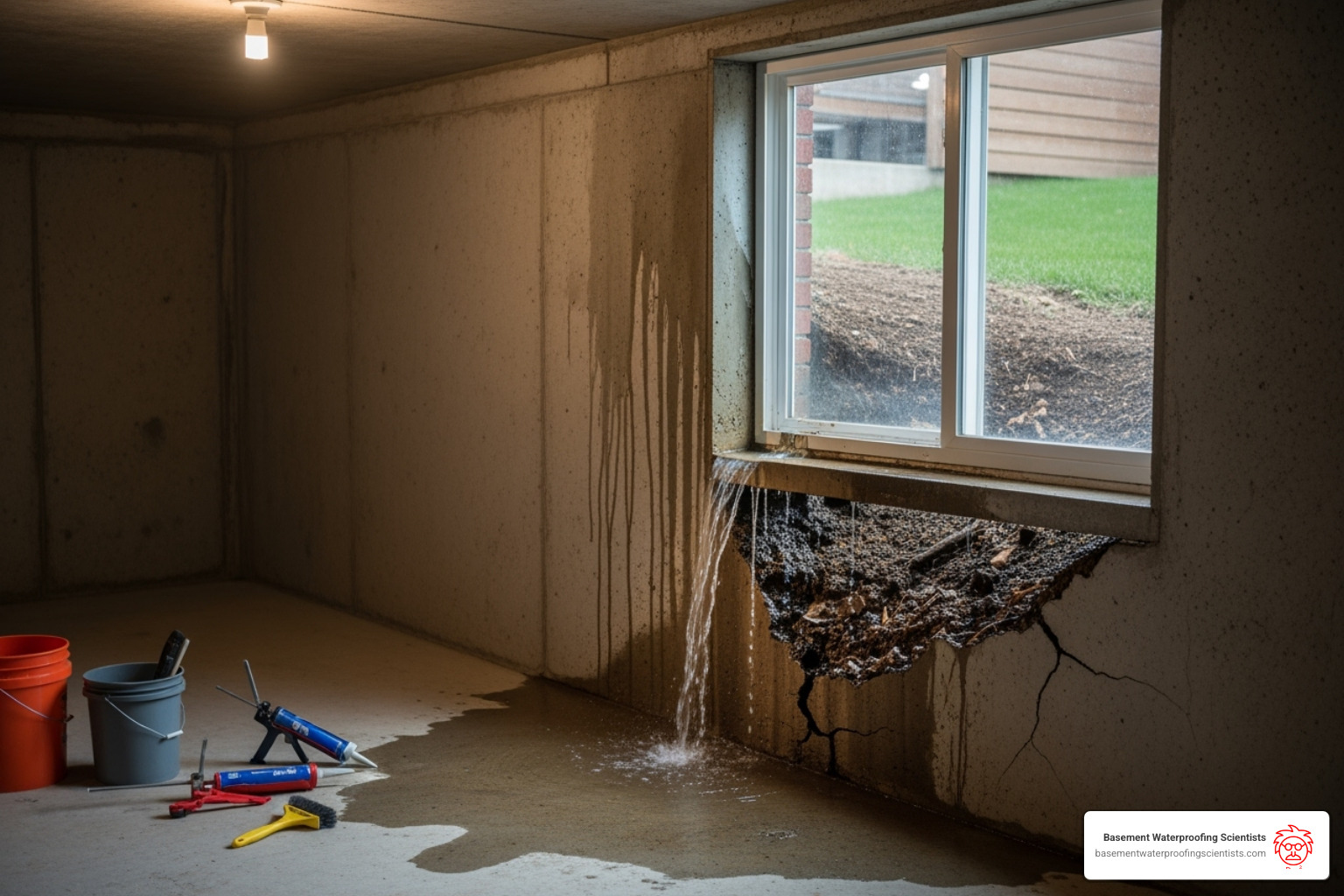
This fix may be temporary if the root cause is a larger issue like poor grading.
Fix #2: The Role of Window Wells in Your Basement Window Leak Repair
Window wells let in light but can cause leaks if not maintained. Proper care is a key part of basement window leak repair.
- Clear debris: Regularly clean out leaves, dirt, and twigs. This debris can clog the drain and turn your well into a small pool.
- Check drainage: If your well has a drain, test it by pouring a bucket of water in. If it drains slowly or not at all, the drain is clogged.
- Add gravel: A layer of crushed stone at the bottom of the well helps water drain away from the window. Fill the well with gravel to about 6-8 inches below the windowsill.
- Install a window well cover: A clear, durable cover is the best way to keep debris and rain out of the well while still allowing light in.
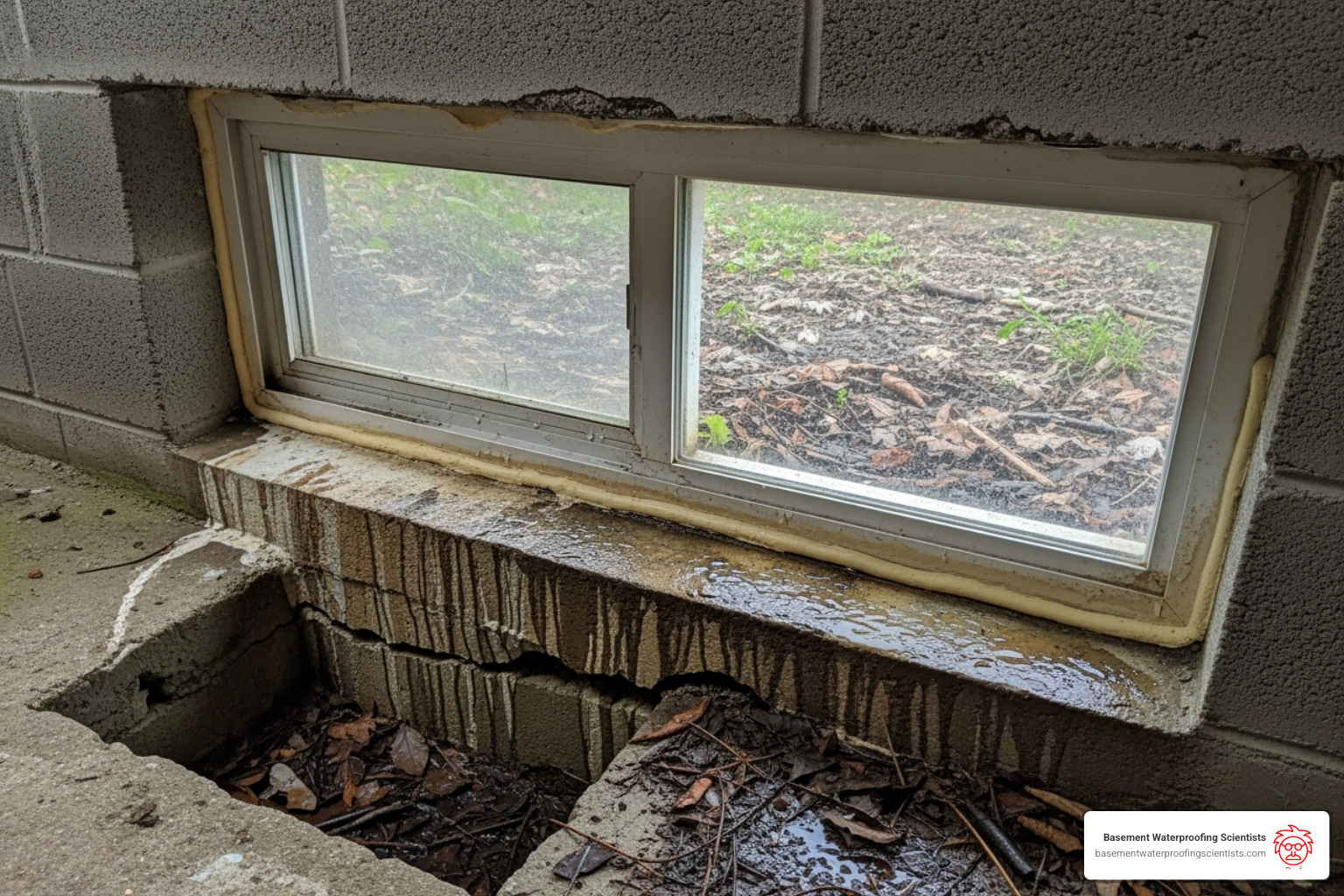
Properly maintained window wells protect your windows and help prevent leaks.
Fix #3: Gutter and Downspout Maintenance
Your gutters have everything to do with your basement windows. They are designed to carry rainwater away from your home. When they fail, that water ends up right next to your foundation, creating pressure that leads to leaks.
- Clean clogged gutters: Gutters packed with debris will overflow, dumping water next to your foundation.
- Use downspout extensions: Ensure your downspouts discharge water at least 5-10 feet away from your house. This is a simple, inexpensive, and highly effective fix.
- Establish a cleaning schedule: Clean your gutters at least twice a year, in the spring and fall. Consider gutter guards to reduce maintenance.
Keeping your gutters and downspouts clear is a critical first line of defense against water intrusion.
Step 4: When to Call a Professional for Basement Window Leak Repair
While DIY fixes can solve minor issues, some leaks are symptoms of deeper problems that require an expert. Knowing when to call a professional for your basement window leak repair can save you time, money, and future headaches.
Signs You Need an Expert Assessment
It’s time to call in the pros if you see any of the following:
- Visible foundation cracks: Cracks wider than a hairline, or those running diagonally, may indicate structural issues. These require professional Basement Crack Repair NJ for a permanent solution.
- Persistent leaks after DIY fixes: If you’ve re-caulked and cleaned your gutters but the water keeps returning, the cause is more complex than a surface issue. Our specialized equipment can accurately find the true source.
- Major grading issues: If your yard slopes towards your house, it may require professional re-grading with heavy equipment to properly redirect water flow.
- Bowing or leaning foundation walls: A bulging or leaning wall is a critical structural problem that needs immediate professional attention to prevent further damage.
- Signs of mold and fungus growth: Extensive mold and fungus growth indicates a chronic moisture problem and poses serious health risks. Professional remediation is necessary to handle it safely.
- Hydrostatic pressure: If water seeps through the concrete itself, you’re likely dealing with groundwater pressure that requires a professional drainage solution.
What a Professional Solution Involves
When you call Basement Waterproofing Scientists, you get a comprehensive, permanent solution custom to your home.
Our process begins with a comprehensive inspection using specialized equipment to accurately diagnose the root cause of the leak. This ensures we fix the problem correctly and cost-effectively.
Depending on our findings, a professional solution may include:
- Exterior Waterproofing: Excavating to apply a waterproof membrane and installing exterior French drains.
- Interior Drainage Systems: Installing a perimeter drain inside your basement to collect water and direct it to a sump pump.
- Sump Pump Installation: A high-quality sump pump system to automatically remove water from your basement.
- Foundation Repair: Using techniques like crack injection or carbon fiber reinforcement to stabilize your foundation. We are specialists in Foundation Repair Philadelphia.
- Professional Window Well Solutions: Installing durable covers and integrated drainage systems.
We create custom waterproofing strategies for every home, backed by a lifetime guarantee for lasting peace of mind.

Frequently Asked Questions about Basement Window Leaks
We’ve covered a lot about basement window leak repair, but here are quick answers to some of the most common questions we hear.
What are the long-term consequences of ignoring a leaky basement window?
Ignoring a leak is a costly mistake. That small drip can lead to:
- Structural Damage: Persistent moisture can weaken your home’s foundation, rot wooden beams and joists, and lead to expensive structural repairs.
- Mold and Fungus Growth: Damp basements are a perfect breeding ground for mold, which can damage your home and pose serious health risks to your family. Of households with basement moisture, 30% develop mold.
- Ruined Belongings: Water and mold can destroy stored items like furniture, photos, and documents.
- Decreased Property Value: A wet basement is a major red flag for potential buyers and can significantly lower your home’s value.
Addressing a leak early is always cheaper than dealing with the consequences of a long-term problem.
How much does professional basement window leak repair cost?
The cost of professional basement window leak repair varies widely because it depends on the root cause of the problem.
A simple DIY fix like a tube of caulk might cost under $10. A professional window well cover can range from $50-$200.
If the problem is more complex, such as a foundation crack repair, costs can range from a few hundred to over a thousand dollars. For widespread issues like hydrostatic pressure that require a full basement waterproofing system (e.g., interior drains and a sump pump), the average cost is between $4,000 and $8,000.
To understand your specific needs, it’s best to get a Basement Waterproofing Cost Estimate from a qualified professional. We offer free, comprehensive inspections to provide an accurate quote without recommending unnecessary work.
Can I just replace the window to stop the leak?
Sometimes, yes. If your window is old, rotted, or damaged, a new, properly sealed window can solve the problem. In this case, the window itself is the cause of the leak.
However, the window is often just the symptom of a larger issue. If the leak is caused by poor grading, clogged window wells, or hydrostatic pressure, a new window will eventually leak too. The external forces pushing water into your basement will compromise even a brand-new installation.
For a permanent basement window leak repair, it’s crucial to identify and fix the true source of the water. This ensures you solve the problem once and for all, rather than applying a temporary fix.
A Permanent Solution for a Dry, Healthy Basement
A leaky basement window is more than a nuisance; it’s a warning sign. Ignoring a small leak can lead to major headaches, including thousands in structural damage, hazardous mold, and ruined belongings.
Proactive basement window leak repair protects your home’s value and your family’s health. A dry basement is a usable, healthy space that adds value to your home and provides peace of mind during every storm.
While DIY fixes are great for minor issues, some problems require professional expertise. For complex issues, the experts at Basement Waterproofing Scientists use specialized equipment to diagnose and permanently solve water problems. With over 30 years of experience, our accurate diagnosis is the key to fixing leaks effectively and for less money.
We create customized waterproofing strategies custom to your home’s unique challenges, from hydrostatic pressure to foundation issues. We don’t believe in one-size-fits-all solutions.
If you’re in New Jersey and need a definitive solution, don’t wait for the next storm. Our comprehensive inspections are free, and we provide honest answers to fix your leak for good.
Ready to reclaim your basement? Get your free estimate for basement waterproofing in NJ today!


